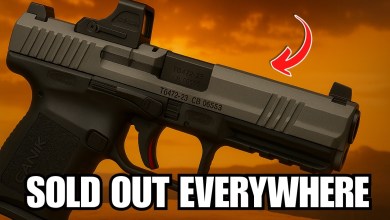Sharp in Every Way: CRKT Q Compact Liner Lock Review

Standing in the media room at CRKT’s headquarters in Tualatin, Ore., I was awed by the array of knives on the wall. Dozens and dozens of models, many of them represented with various iterations in color and finish. Quite a few I recognized from my own collection at home, such as the Sting, the M16, and various flavors of the Provoke.
Chatting later with Kyle Stuart, then marketing manager and now CRKT VP of marketing, he mentioned a new release he felt I might find interesting. He sent one over for me to check out, and when it arrived, I was blown away.
The Q Compact Liner Lock arrived in a handsome black magnetic box. Nestled inside was a lined zippered pouch, inside which lay the knife. It’s a lot of presentation for a folding knife, but once I lifted the knife from the pouch, I understood why.
I’m not normally a carbon fiber kind of guy, but the black and copper swirls on the Q Compact Liner Lock were absolutely stunning, and the overall impression was one of working man’s luxury. By that, I mean it looks amazing but it isn’t so high-end that you’ll be afraid to use it.
I’m not normally a carbon fiber kind of guy, but the black and copper swirls on the Q Compact Liner Lock were absolutely stunning.
In short: The Q Compact Liner Lock is a smaller version of the custom Q folding knife designed by Richard Rogers. It’s lightweight, looks amazing, and performs well enough to qualify for regular EDC rotation.
-
Lightweight and easy to carry -
Carbon fiber inlay looks amazing -
Flipper open is fast -
Lockup is rock-solid
-
Feels too light for heavy-duty chores
CRKT Q Compact Liner Lock Review
Something I’ve long admired about CRKT is the brand’s dedication to collaboration. It continually seeks out designers who are doing great work and partners with them for production runs of custom designs. Such is the case here.
The Q Compact Liner Lock is a slightly scaled-down version of a custom knife designed and produced by New Mexico knife maker Richard Rogers.
It didn’t take long to realize that this isn’t just pocket jewelry, though. I worked it into my regular EDC knife rotation and carried it off and on for nearly 3 months. The Q Compact Liner Lock performed admirably well with just about everything I asked of it. Along the way, it also caught a few people’s attention.
Design and Construction
CRKT uses a wide range of materials for its product line. For the Q Compact Liner Lock, the brand went with S35VN steel. This is a stainless steel with a well-earned reputation for edge retention. It’s a great choice for a folding knife, particularly one that could see use in both damp and dry environments.
Make no mistake, in the middle of July, your front pocket likely qualifies as a damp, humid environment.
The frame is aluminum, providing an excellent balance between weight and strength. The carbon fiber scales add very little weight to the mix. At just 2 ounces, according to the specs (and my scale), this knife all but disappears in the pocket.
The handle is smooth to the touch, but contoured such that it never feels like it’s going to slip out of your hand. I have large hands and can get about 3.5 fingers around it.
The DLC coating on the blade provides an extra layer of protection against moisture, and adds some visual appeal. As a general rule of thumb, I don’t usually favor blade coatings, preferring more of a stonewash finish. But combined with the black frame and the copper-patterned scales, the black blade works well here.
The blade is just a hair under 3 inches, keeping it legal in areas where 3 inches is the magic number between getting a ticket and confiscation or not. It has a straight-back profile with a needle-sharp point.
The Q Compact Liner Lock is a flipper-style knife. While the flipper itself is quite small, the blade swings into position very fast, owing to the IKBS ball bearing pivot.
The blade’s liner lock engages the base of the blade fully. While there’s no such thing as a foolproof lock when it comes to knives, this one comes close. I’m particularly fond of liner locks because you can close them with one hand. Just push the lock to the side with your thumb and use your index finger to rotate the blade closed.
A deep-carry pocket clip rounds out the package. It is non-reversible and positions the knife tip up in the pocket.
Q Compact Performance
Over the last several weeks, I’ve used the Q Compact Liner Lock for a range of tasks. At the outset, I wasn’t looking to put it through any specific sorts of tests. Instead, I just carried it and put it to use whenever I needed a sharp blade.
Along the way, it helped me break down countless boxes and open various blister pack packages. It sliced and diced cheese, carrots, and apples for my adorable granddaughter. I even used it to shave tinder for one of our Friday night campfires.
The Q Compact Liner Lock did a great job in every role. The blade was razor-sharp right from the get-go. The handle was comfortable, even when applying significant pressure to get a couple of packages open.
At that point, I decided some formal testing might be in order, if nothing else than to codify the knife’s performance. Luckily, as a longtime knife junkie, I have a couple of boxes of bits and pieces of material that have been saved for just such an occasion.
The first thing I grabbed was a hank of paracord. I use this cordage a fair bit around the house as well as when I’m out in the field, so I have a ton of it kicking around. I lopped off about 2 feet of it and went to work.
I looped segments of it around the Q Compact’s blade, and it sliced through easily, even doing three and four loops at a time. Tossing the cut bits down, I used a press cut to part them into smaller and smaller pieces. Absolutely no issues with either of these tests.
Next up was an old leather strap. I think it may have come from a purse my wife had once upon a time. Slicing it up was no trouble at all. If anything, I was kind of disappointed it went as quickly as it did, as I was having fun with it.
Then I spotted a couple of pieces of thin, webbed belt. I have no clue where these came from or how they ended up in my scrap box. In just a few moments, they were reduced to just a pile of bits.
Handling
When I am reviewing and testing a knife, I never sharpen it, nor do I oil it. I want to see how well it holds up right out of the box, without any maintenance or help at all. I couldn’t even begin to guess how many times I’ve opened and closed the knife, but it has never once failed to open completely.
The blade snaps into position nearly as quickly as I’d expect from an assisted-open model. The lock-up is solid, giving you great confidence with the knife. As a bonus, closing the knife isn’t terrible, as the liner lock is fairly easy to push aside.
The Q Compact Liner Lock is still amazingly sharp, even after several weeks of use. Now, granted, I’m not using it to slice through drywall, cut open bags of concrete, or carve wooden figurines. But it’s also not the type of knife I’d expect to use for heavy-duty chores like those.
This is more office and suburbia than it is construction site and dive bar. That’s not a bad thing, as carrying a Buck 110 on your belt when you show up to the district sales meeting on Thursday may be frowned upon.
On the other hand, when that work crush asks if you can help open a new box of toner cartridges, the Q Compact Liner Lock might turn into a great conversation starter.
Q Compact Liner Lock: Who Should Buy It?
The Q Compact Liner Lock is perfect for those seeking a very functional, but higher-class, EDC knife. It may not be well-suited for rough and tumble chores, if only because you might hesitate marring the carbon fiber scales. But for a nice office carry, something you can drop into your business casual slacks, it’s an ideal option.
The Q Compact Liner Lock is available now. This model with the copper carbon fiber runs $200. If you go with G10 inlay scales instead, you’ll save five bucks. But you won’t be quite as cool. You can find it at CRKT.
Read the full article here








